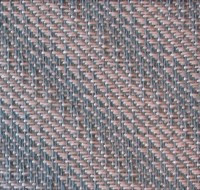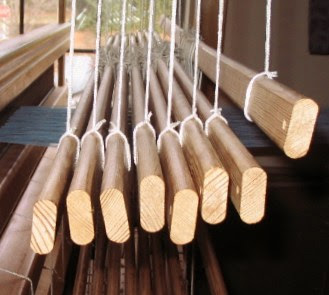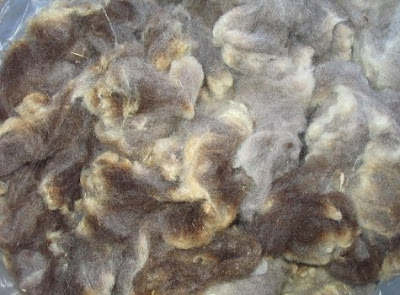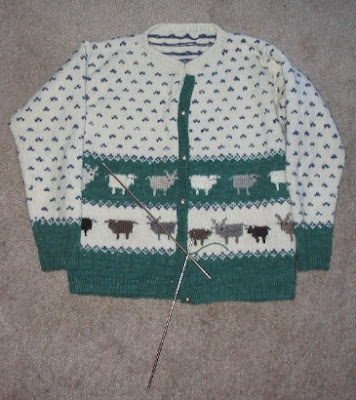Firstly, I want to thank everyone for all your encouraging comments and suggestions on my
last post. I got some confirmation on some ideas I had already been tossing around, and some things I hadn't considered, but which would be very do-able, if not radical! I was very interested in your different opinions, which helped me realize that the final results are very much subjective.
I did happen to find a 30 inch strand of green, hopefully enough to finish those 20 stitches! But that still leaves the neck band, which I really prefer would match the front bands, so I worked on two possible solutions over the weekend. I figured that I'd start with these, and then move on to another idea if neither one worked.
The first, was to knit some swatches to see if I couldn't come up with a two color band, imitating the Fair Isle stitches I'd used in the sweater. My problem here, was that I couldn't figure out how to adapt Fair Isle to a k1p1 ribbing.
The other thing I decided to try, was to dye some of the white yarn to see how well I could match the green. I realize that the chances of actually accomplishing this were slim to none, but I thought I'd give it a try anyway. My first major at university was painting, and one thing I had was an eye for matching color. It wasn't something I could explain how I did, but by mixing paints on my palette, I could match any color on anybodies canvas. However, I know that dyes don't work the same way paints do, but I still had to give it a try even if only to prove to myself that I couldn't do it.
I knew that the green in the sweater was Cushings, and I seemed to recall that the old dyestocks I have on hand were mixed at the same time. I was out of the Ocean Green, but still had some Lemon and Sky Blue dyestocks leftover. So I set about, adding one spoonful of each at a time, turning up the heat, and checking my progress.

I kept a small snippet of the yarn I was trying to match in a bowl of water. this way I could compare the colors while wet, as I know that colors lighten some with drying.
When I got to the point where the color values were about the same, my green experimental skein was still a tad too bright. So I mixed a little Scarlet dyestock and added a smidgen in hopes it would dull it enough. Here is a photograph of the results...

And below is a scan of the newly dyed skein with that 30 inch strand of original green yarn mixed in. The scan didn't turn out the same color as the photo, but it is still useful for a comparison.....

What do you all think???? Would anyone notice if I used it for the neckband????
One difference I notice is that I did a better job on the new skein. The original skeins were a little spotty, which shows up in the knitting. Still, if was just for the neckband........ maybe it would work?
 .... which have become three yarns....
.... which have become three yarns.... I didn't make extensive spinning notes on these, but I can tell you that the
black and grey are British Shetland. Their fibers measured five to six inches in
length. I got both of these from
Woodland Woolworks. The black had some interesting white fibers scattered here and there
throughout. I bought the moorit from
Paradise Fibers
(way back when Kate owned it) and it's fiber length averages four inches.
I didn't make extensive spinning notes on these, but I can tell you that the
black and grey are British Shetland. Their fibers measured five to six inches in
length. I got both of these from
Woodland Woolworks. The black had some interesting white fibers scattered here and there
throughout. I bought the moorit from
Paradise Fibers
(way back when Kate owned it) and it's fiber length averages four inches.





















